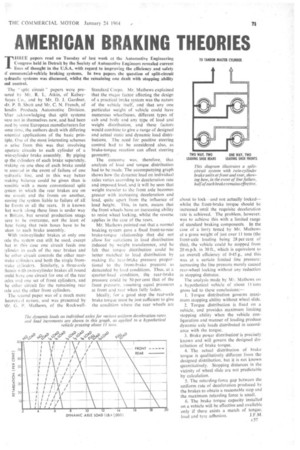AMERICAN BRAKING THEORIES
Page 73

If you've noticed an error in this article please click here to report it so we can fix it.
THREE papers read on Tuesday of last week at the Automotive Engineering Congress held in Detroit by the Society of Automotive Engineers revealed current lines of thought in the U.S.A. with regard to improving the efficiency and safety )1 commerc:al-vehicle braking systems. In two papers the question of split-circuit aydraulic systems was discussed, whilst the reinaining one dealt with stopping ability md control.
The split circuit" papers were prelated by Mr.. R. L. Atkin, of Kelsey-layes Co.. and by Mr. D. J. Gardner, qr. P. B. Shutt and Mr. C. N. French, of 3endix Products Automotive Division. kfter acknowledging that split systems vere not in themselves new, and had been ased by some European manufacturers for ome time, the authors dealt with differing iotential applications of the basic prin. iple. One of the most interesting schemes o arise from this was that involving ,eparate circuits to each cylinder of a win-cylinder brake assembly. By piping ip the cylinders of each brake separately, n-aking on one shoe of each brake could )e assured in the event of failure of one tydratilic line, and in this way better )raking balance could be given than is mssible with a more conventional split iystem in which the rear brakes are on me circuit and the fronts on another, caving the system liable to failure of all he fronts or all the rears. It is known hat work along these lines is under way n Britain. but several production snags lave to be overcome, not the least of hese being that twin hoses have to be aken to each brake assembly.
With twin-cylinder brakes at only one txle the system can still be used, except hat ir this case one circuit feeds one :ylinder in each of the rear brakes and he other circuit controls the other rear)rake cylinders and both the single frontnake cylinders. Similarly, a three-axle ilassis with twin-cylinder brakes all round :mild have one circuit for one of the rear ales and one set of front cylinders, and he other circuit for the remaining rear txle and the other front cylinders.
The second paper was of a much more heoretictil nature, and was presented by qr. G. P. Mathews, of the Rockwell Standard Corpn. Mr. Mathews explained that the major factor affecting the design of a practical brake system was the nature of the vehicle itself, and that any one particular weight of vehicle could have numerous wheelbases, different types of cab and body and any type of load and weight distribution, and these factors would combine to give a range of designed and actual static and dynamic load distributions. 'the need for positive steering control had to be considered also, as brake-torque reaction can affect steering geometry.
The outcome was, therefore, that analysis of load and torque distribution had to be made. The accompanying graph shows how the dynamic load on individual axles varies according to deceleration rate and imposed load, and it will be seen that weight transfer to the front axle becomes greater with increasing deceleration and toad, quite apart from the influence of load height. This, in turn, means that the front wheels have an increasing ability to resist wheel locking, whilst the reverse applies in the case of the rears.
Mr. Mathews pointed out that a normal braking system gave a fixed front-to-rear brake-torque relationship that did not allow for variations in load distribution induced by weight transference, and he felt that torq Lie distribution could be better matched to load distribution by making the rear-brake pressure proportional to the front-brake pressure as demanded by load conditions. Thus, at a quarter-load condition, the rear-brake pressure could be 50 per cent that of the front pressure. assuming equal pressures at front and rear when fully laden.
Ideally, for a good stop the rear-axle brake torque must be just sufficient to give the condition where the rear wheels are
about to lock--and not actually locked— whilst the front-brake torque should be increased until the requisite deceleration rate is achieved, The problem, however, was to achieve this with a limited range of standard braking components. In the case of a lorry tested by Mr. Mathews at a gross weight of just over It tons (the front-axle loading being 28 per cent of this), the vehicle could be stopped from 20 mph. in 30 ft., which is equivalent to an overall efficiency of 0-45 g., and this was at a certain limited line pressure: increasing the line pressure merely caused rear-wheel locking without any reduction in stopping distance.
The analysis made by Mr. Mathews on a hypothetical vehicle of about II tons gross led to these conclusions: 1. Torque distribution governs maximum stopping ability without wheel slide.
2. Torque distribution is fixed on a vehicle, and provides maximum limiting stopping ability when the vehicle configuration and manner of loading produce dynamic axle loads distributed in accordance with the torque.
3. Brake power distribution' is precisely known and will govern the designed distribution of brake torque.
4. The actual distribution of brake torque is qualitatively different from the designed distribution, but it is not known quantitatively. Stopping distances in the vicinity of wheel slide are not predictable by calculation. 5. The retarding-force gap between the uniform rate of deceleration produced by the brakes to obtain a reasonable stop and the maximum retarding force is small.
6. The brake torque capacity installed on a vehicle will he effective and available only if there exists a match of torque.
toad and tyre adhesion. I. F. M.
























































































































